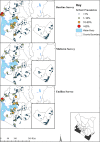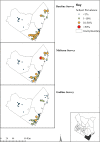Results of a national school-based deworming programme on soil-transmitted helminths infections and schistosomiasis in Kenya: 2012-2017
- PMID: 30732642
- PMCID: PMC6367841
- DOI: 10.1186/s13071-019-3322-1
Results of a national school-based deworming programme on soil-transmitted helminths infections and schistosomiasis in Kenya: 2012-2017
Abstract
Background: Soil-transmitted helminth (STH) and schistosome infections are among the most prevalent neglected tropical diseases (NTDs) in the world. School-aged children are particularly vulnerable to these chronic infections that can impair growth, nutritional status and cognitive ability. Mass drug administration (MDA) delivered either once or twice annually is a safe and effective approach recommended by the World Health Organization (WHO) to reduce worm burden. In 2012, Kenya began a national school-based deworming programme (NSBDP) aimed at reducing infection and associated morbidity. The change in prevalence and intensity of these infections was monitored over five years (2012-2017). Here, we present the changes in STH and schistosome infections between baseline and endline assessments, as well as explore the yearly patterns of infection reductions.
Methods: We used series of pre- and post-MDA intervention, repeat cross-sectional surveys in a representative, stratified, two-stage sample of schools in 16 counties of Kenya. The programme consisted of two tiers of monitoring; a national baseline, midterm and endline surveys consisting of 200 schools, and pre- and post-MDA surveys conducted yearly consisting of 60 schools. Stool and urine samples were collected from randomly selected school children and examined for STH and schistosome infections using Kato-Katz and urine filtration techniques respectively.
Results: Overall, 32.3%, 16.4% and 13.5% of the children were infected with any STH species during baseline, midterm and endline assessment, respectively, with a relative reduction of 58.2% over the five-year period. The overall prevalence of S. mansoni was 2.1%, 1.5% and 1.7% and of S. haematobium was 14.8%, 6.8% and 2.4%, respectively, for baseline, midterm and endline surveys. We observed inter-region and inter-county heterogeneity variation in the infection levels.
Conclusions: The analysis provided robust assessment of the programme and outlined the current prevalence, mean intensity and re-infection pattern of these infections. Our findings will allow the Government of Kenya to make informed decisions on the strategy to control and eliminate these NTDs. Our results suggest that complimentary interventions may have to be introduced to sustain the chemotherapeutic gains of MDA and accelerate attainment of elimination of these NTDs as a public health problem in Kenya.
Keywords: Schistosomiasis; School-based deworming; Soil-transmitted helminths.
Conflict of interest statement
Ethics approval and consent to participate
The study protocol received ethical approval from the KEMRI’s Scientific Steering Committee and the Ethics Review Committee (SSC No. 2206). Additional approval was provided by the appropriate county-level health and education authorities, who were briefed appropriately about the surveys. At the school level, parental consent was based on passive, opt-out consent rather than written opt-in consent due to the low risk and routine nature of the study procedure. Individual assent was obtained from each child before participation in the surveys.
Consent for publication
Not applicable.
Competing interests
The authors declare that they have no competing interests.
Publisher’s Note
Springer Nature remains neutral with regard to jurisdictional claims in published maps and institutional affiliations.
Figures









Similar articles
-
Monitoring the impact of a national school based deworming programme on soil-transmitted helminths in Kenya: the first three years, 2012 - 2014.Parasit Vectors. 2016 Jul 25;9(1):408. doi: 10.1186/s13071-016-1679-y. Parasit Vectors. 2016. PMID: 27457129 Free PMC article.
-
Prevalence, intensity and associated risk factors of soil-transmitted helminth and schistosome infections in Kenya: Impact assessment after five rounds of mass drug administration in Kenya.PLoS Negl Trop Dis. 2020 Oct 7;14(10):e0008604. doi: 10.1371/journal.pntd.0008604. eCollection 2020 Oct. PLoS Negl Trop Dis. 2020. PMID: 33027264 Free PMC article.
-
Initiating NTD programs targeting schistosomiasis and soil-transmitted helminthiasis in two provinces of the Democratic Republic of the Congo: Establishment of baseline prevalence for mass drug administration.Acta Trop. 2017 Feb;166:177-185. doi: 10.1016/j.actatropica.2016.11.023. Epub 2016 Nov 22. Acta Trop. 2017. PMID: 27888125
-
Soil-transmitted helminths and schistosome infections in Ethiopia: a systematic review of progress in their control over the past 20 years.Parasit Vectors. 2021 Feb 5;14(1):97. doi: 10.1186/s13071-021-04600-0. Parasit Vectors. 2021. PMID: 33546757 Free PMC article.
-
Prevalence of soil-transmitted helminth infections, schistosomiasis, and lymphatic filariasis before and after preventive chemotherapy initiation in the Philippines: A systematic review and meta-analysis.PLoS Negl Trop Dis. 2021 Dec 20;15(12):e0010026. doi: 10.1371/journal.pntd.0010026. eCollection 2021 Dec. PLoS Negl Trop Dis. 2021. PMID: 34928944 Free PMC article.
Cited by
-
Effectiveness of mass treatment of Schistosoma mansoni infection in socially vulnerable areas of a state in northeastern Brazil, 2011-2014.Arch Public Health. 2021 Mar 9;79(1):30. doi: 10.1186/s13690-021-00549-9. Arch Public Health. 2021. PMID: 33750474 Free PMC article.
-
Precision mapping of schistosomiasis and soil-transmitted helminthiasis among school age children at the coastal region, Kenya.PLoS Negl Trop Dis. 2023 Jan 5;17(1):e0011043. doi: 10.1371/journal.pntd.0011043. eCollection 2023 Jan. PLoS Negl Trop Dis. 2023. PMID: 36602986 Free PMC article.
-
A positive consequence of the COVID-19 pandemic: how the counterfactual experience of school closures is accelerating a multisectoral response to the treatment of neglected tropical diseases.Philos Trans R Soc Lond B Biol Sci. 2023 Oct 9;378(1887):20220282. doi: 10.1098/rstb.2022.0282. Epub 2023 Aug 21. Philos Trans R Soc Lond B Biol Sci. 2023. PMID: 37598709 Free PMC article. Review.
-
Schistosomiasis Interventions in Africa: Assessment and Systematic Review.J Parasitol Res. 2025 Aug 13;2025:2125107. doi: 10.1155/japr/2125107. eCollection 2025. J Parasitol Res. 2025. PMID: 40842558 Free PMC article. Review.
-
High burden of soil-transmitted helminth infections, schistosomiasis, undernutrition, and poor sanitation in two Typhoon Haiyan-stricken provinces in Eastern Philippines.Pathog Glob Health. 2021 Sep;115(6):412-422. doi: 10.1080/20477724.2021.1920777. Epub 2021 May 6. Pathog Glob Health. 2021. PMID: 33956588 Free PMC article.
References
-
- WHO . Accelerating work to overcome the global impact of neglected tropical diseases: a roadmap for implementation: executive summary. Geneva: World Health Organization; 2012. pp. 1–42.
-
- WHO . Investing to overcome the global impact of neglected tropical diseases: third WHO report on neglected diseases 2015. Geneva: World Health Organization; 2015.
MeSH terms
Substances
Grants and funding
LinkOut - more resources
Full Text Sources
Molecular Biology Databases

